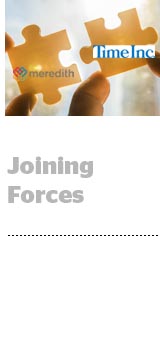
Meredith Corp’s agreement to acquire Time Inc. for $1.85 billion, announced Sunday, will test whether Meredith’s sales org leadership can benefit from Time’s programmatic technology – and vice versa.
In terms of ad sales, it’s a tale of two different strategies.
Time Inc. struggled in the wake of a chaotic sales reorg that caused ad revenue to decline throughout 2017 – most recently by 12% YoY in Q3. Time’s digital ad revenue did grow 10% YoY – but only 2% factoring in revenues from the self-serve ad platform Viant, which was hit by an early-year client loss. Regardless, any digital gains couldn’t offset the 18% decline in print revenue.
Time Inc.’s Q4 outlook for both print and digital was also dim, said CEO Richard Battista during the company’s Q3 call in November. Instead of focusing on digital, he seemed intent on rejuvenating Time’s print advertising, stating his goal of “reimagining print to create better and financially healthier print products.”
Meredith has ad sales units focused on its national properties ($239 million in revenue with flat digital ad growth last quarter) and its local ones ($154 million in revenue with 14% digital ad growth last quarter). In recent years, Meredith has tried to create more synergies between its local and national media groups.
Meredith is also distinct because it has steadily focused on client relationships, particularly toward setting up private market places.
Among the publisher’s top clients over the last 100 years, “97 of them are still going to be our clients [over the next 100],” said data and programmatic VP Chip Schenck on a recent AdExchanger podcast.
While Meredith is clearly confident in its ability to conduct direct relationships with digital advertisers, and this is an area where Time, which is still figuring out how to manage programmatic direct deals, could improve.
In its November earnings call, Time’s COO and digital president, Jennifer Wong, described direct deals as “an opportunity for us” – which the publisher would realize if it could make programmatic “more of a core piece of our solution.” She added that the pub was still positioning its sales force to be able to execute on that vision.
And what about Time’s self-serve programmatic business, which comes from its acquisitions of the ad platform Viant and mobile demand-side platform Adelphic?
Viant, built on the back of ad tech acquisitions and data from Myspace, enables Time Inc. to sell people-based inventory against its subscriber base, link devices to real people and measure attribution on its properties.
That seems like a nice value proposition, but is managing a digital ad platform business something that Meredith would want to continue? Moreover, how much of Time’s audience is valuable to Meredith, which typically focuses on women over 30?
Time Inc declined to comment. Meredith did not respond to a request for comment.
Ryan Joe contributed.
This post was syndicated from Ad Exchanger.

More Stories
The NY Post Is Turning First-Party Data Into Direct Deals, With A Little Help From Its Friends
New board member for Blutui
Brave Commerce: Centering the Consumer in the CPG Industry